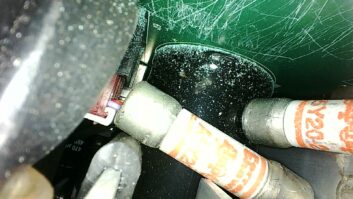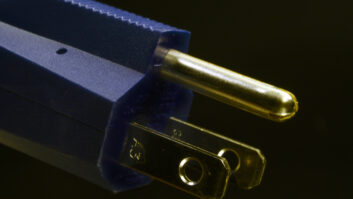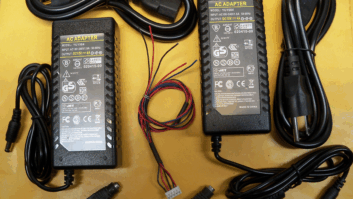Phillip Vaughn writes from his group of stations in Colton, Calif., about a great product for cable management.
He had been using Panduit but found it costly and started looking for alternatives. He came across a product from Middle Atlantic called a Lacer bar.
It comes in horizontal and vertical flavors, as seen in the attached images. They don’t offer a cover to hide the cables, like Panduit’s do; but when installed in the rear of a rack, the cables are hidden anyway.
As a matter of fact, you can see from Figs. 1 and 2 that the wiring can be accessed and viewed quickly, yet still look clean and well managed. Phillip finds that the Lacer bars allow for much cleaner wire management because cables are secured with Velcro hook-and-loop fastener, not cable ties. Cables can be separated and bundled according to signal type or however you wish to deal with them.

Fig. 1: A horizontal lacing bar from Middle Atlantic organizes cabling in a rack.

Fig. 2: The bars also can be installed vertically.
It goes without saying that being able to wire your racks neatly in this fashion allows for much quicker troubleshooting when you need to trace down a cable. And when using Velcro straps, you can make changes to your system easily. Thanks, Phillip, for the great suggestion.
It’s interesting how what’s old becomes new. Lacing bars were used in racks with waxed lacing cord years before Panduit hit the scene. If you’re new to broadcast engineering, you might find some examples touring old radio, TV or even telco facilities.
The wires are laced neatly, and the workmanship is magnificent. But unlike the lacing of old, the Velcro feature that Middle Atlantic added to its lacing bars makes adding or removing wires much easier. Contact your broadcast dealer for more information.
* * *

Fig. 3: Wilderness Medical Systems says its WMS Grasshopper is its most popular personal medical kit. So how are your survival supplies coming along?
We talked about supplies to keep at your transmitter site, so that you’ll be prepared should you become stranded someday. After food and water should be a first aid kit. You can pick up small kits at discount super stores, but I encourage you to see what’s online.
One company, Wilderness Medical Systems, provides a compact yet complete medical kit for around $220. The WMS Grasshopper is small enough to store under your vehicle’s seat or in the trunk. In addition to typical medical supplies like bandages, it includes a survival blanket, splinting material, surgical soap and a “super-glue” that is state of the art for wound closure.
Included are WMS Flashcards. These are waterproof, tear-proof cards outlining first aid solutions for wilderness medical emergencies.
The company offers a variety of kits and at different price points.
Less costly solutions can be found at Adventure Medical Kits. Some of their kits are less than $50.
This company offers some additional items you may want to consider. Fresh Bath Body Wipes will keep your hygiene in check. The Blister Medic kit provides solutions to blisters, which might not be an issue if you are stranded, but certainly should be considered if you’re going to NAB!
For more serious injuries, QuickClot comes in a variety of package sizes. Broken bones and sprains can be stabilized with its splinting materials and elastic wraps. Many of this company’s offerings are a la carte, so you can buy the specific products you need.
One such example is the Core Lite survival knife. It combines a 10 Lumen LED light and a short, steel blade. A 100 dB rescue whistle is built into the handle.
A good survival knife of some sort should be a part of your kit. What makes this one nice is the LED shines down the length of the blade to help you see what you’re cutting in the dark, but it’s also bright enough to use as a light source should you lose power. The best feature: It’s just $20.

Fig. 4: It’s a knife. It’s a light. It’s a whistle. Emergency Medical Products has what could be a useful Earthquake Survival Kit. Selling for less than $40, this kit includes 12 drinking water packs, a food pack, a silver rescue blanket, antiseptic wipes, bandages and gauze pads, plus a light stick. For a basic, no-frills survival pack, at this price, you could put one at each transmitter site.
EMP also provides a variety of disaster readiness and emergency preparedness kits varying in price from $14 to $100.
Whatever you select, be sure to have some kind of first aid supplies at your transmitter. Here’s hoping you’ll never need them.
John Bisset marked his 40th year in radio in broadcasting recently. He works for Tieline Technology and is a past recipient of the SBE’s Educator of the Year Award. Reach him at [email protected] or (603) 472-5282. Faxed submissions can be sent to (603) 472-4944.
Submissions for this column are encouraged and qualify for SBE recertification credit.







